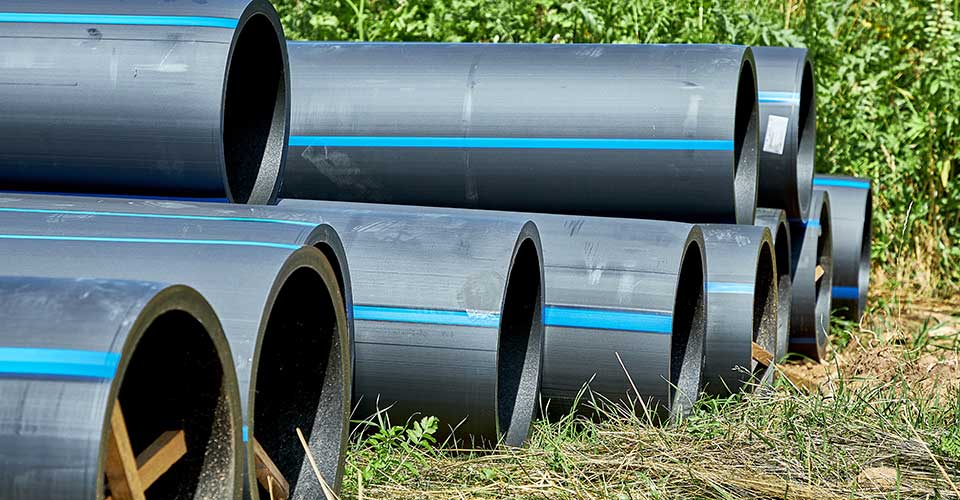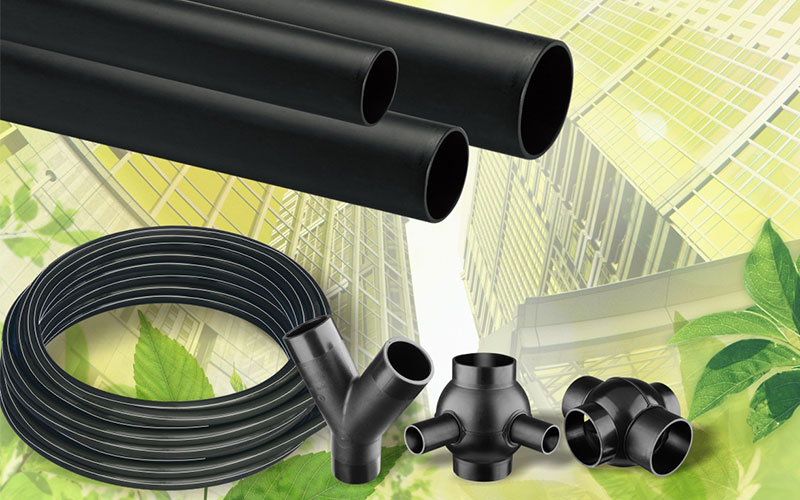Pipe Manufacturing Midland TX: From Raw Material to Finished Pipe
Wiki Article
Explore the Manufacturing Refine Behind High-Quality HDPE Pipe and Its Applications
The production process of high-quality HDPE pipes is elaborate and systematic. It starts with the choice of raw products that boost efficiency. Following this, ethylene undergoes polymerization to form resin, which is then formed via extrusion. Quality control is critical, making sure that the last item meets strict standards. The trip of HDPE pipelines does not finish with manufacturing. Their applications across different markets expose a more comprehensive relevance worth checking out.Recognizing HDPE: Characteristics and Advantages

High-density polyethylene (HDPE) is a functional polycarbonate understood for its resilience and resistance to various ecological variables. This material exhibits exceptional tensile strength, making it ideal for demanding applications. Its low-density framework contributes to a light-weight product, facilitating simplicity of managing and installation. HDPE additionally showcases amazing resistance to chemicals, which reduces deterioration when exposed to harsh substances.
The product's reduced dampness absorption additionally enhances its durability, making it ideal for usage in pipes and tank. In addition, HDPE is resistant to ultraviolet (UV) radiation, making sure that items maintain their stability also when revealed to sunlight. Its flexibility permits for the production of intricate shapes without endangering strength. The environment-friendly nature of HDPE, often originated from recycled materials, includes to its charm, advertising lasting techniques in production. Overall, these buildings and benefits make HDPE a recommended selection for numerous commercial and consumer applications.
Basic Material Selection for HDPE Production
The selection of raw products for HDPE manufacturing is necessary to confirm the final item fulfills the wanted specifications and top quality criteria. High-density polyethylene (HDPE) is largely created from polymerized ethylene, acquired from fossil gas such as natural gas or unrefined oil. The top quality of these feedstocks greatly affects the mechanical and thermal homes of the final HDPE.Ingredients additionally play a considerable function in enhancing HDPE's efficiency, consisting of antioxidants, UV stabilizers, and colorants, which boost durability and resistance to ecological aspects. The selection procedure need to think about not only the chemical make-up of the raw materials yet likewise their processing features to ensure efficient production.
The sourcing of raw materials need to prioritize sustainability and conformity with environmental guidelines, as responsible methods are important in today's market. Inevitably, careful raw product selection lays the foundation for generating high-grade HDPE pipes ideal for diverse applications.
The Extrusion Refine: Forming HDPE Pipe
The extrusion process plays a vital function in forming HDPE pipelines, beginning with careful product preparation methods that assure optimal flow and uniformity. Equally vital is the design of the die, which straight affects the last dimensions and surface area top quality of the pipe. Together, these elements add substantially to the efficiency and high quality of HDPE pipeline manufacturing.Product Prep Work Strategies
Efficient production of HDPE pipes begins with careful product prep work strategies, specifically the extrusion process. During this stage, high-density polyethylene resin is first dried to eliminate moisture, guaranteeing suitable flow qualities. The resin is then fed right into the extruder, where it undertakes home heating and melting, changing into a viscous state. This heating procedure is meticulously regulated to keep the product's stability and performance. The liquified HDPE is compelled with a die, shaping it into a continual pipeline type. Appropriate temperature management throughout extrusion is necessary, as it directly affects the material's residential or commercial properties and the final product quality. Once shaped, the HDPE pipeline is cooled down and reduced to specified lengths, ready for succeeding handling and applications.Die Design Importance
website Accuracy in die style plays a necessary function in the extrusion procedure of HDPE pipes. The die serves as the last shaping tool, straight influencing the pipe's measurements, wall density, and surface coating. A well-designed die guarantees consistent material circulation, minimizing problems such as abnormalities and weak points. The geometry of the die must be optimized to fit the particular residential or commercial properties of HDPE, including its thickness and thermal habits throughout extrusion. In addition, the cooling rate of the product as it goes through the die can considerably influence the pipe's architectural integrity. Subsequently, purchasing sophisticated die technology is crucial for manufacturers aiming to create top quality HDPE pipelines that fulfill industry requirements and consumer assumptions.Quality Assurance Procedures in HDPE Production
Numerous factors influence the quality of HDPE pipe manufacturing, effective high quality control measures are vital to assure uniformity and integrity in the final product (hdpe pipe fittings Midland TX). Trick top quality control methods consist of rigorous product examination, validating that the raw polyethylene satisfies well established standards for purity and thickness. During the extrusion procedure, specifications such as temperature, stress, and cooling time are closely checked to keep dimensional accuracy and architectural stabilityFurthermore, post-production screening is necessary; makers frequently conduct hydrostatic examinations to evaluate the pipeline's strength and resistance to stress. Visual evaluations for surface area flaws even more boost quality control. Accreditation from relevant requirements organizations, like ASTM or ISO, supplies an additional layer of credibility. By carrying out these detailed quality assurance steps, suppliers can minimize defects, boost performance, and guarantee that the HDPE pipelines satisfy the particular needs of various applications, eventually leading to client contentment and rely on the item.
Applications of HDPE Pipeline Across Industries
HDPE pipes are used throughout numerous sectors because of their longevity and flexibility. In water circulation systems, they assure reliable delivery, while in wastewater management, they offer dependable options for waste transportation. In addition, farming watering networks take advantage of HDPE's resistance to corrosion and versatility, making it a suitable selection for modern farming techniques.
Water Circulation Equipments
A considerable variety of sectors depend on high-density polyethylene (HDPE) pipes for reliable water circulation systems. Known for their sturdiness and resistance to deterioration, HDPE pipelines are widely utilized in community water system networks, farming watering, and commercial applications. Their light-weight nature helps with simple handling and setup, lowering labor costs and time. Furthermore, HDPE pipelines can fit numerous stress degrees, making them ideal for both reduced and high-pressure systems. Pipe Supplier American Plastics Midland. The adaptability of the material permits seamless integration right into existing infrastructure, minimizing the need for considerable excavation. HDPE's resistance to chemical leaching assurances that the water supplied remains risk-free and tidy, making it a perfect option for keeping the quality of drinkable water throughout various industries.Wastewater Administration Solutions
Reliable water circulation systems also lead the way for ingenious wastewater administration remedies, where high-density polyethylene (HDPE) pipelines play a significant function. Prominent for their sturdiness and resistance to deterioration, HDPE pipelines are excellent for transporting wastewater in different setups. Their versatility enables simple installment in intricate atmospheres, lessening the need for comprehensive excavation. Additionally, HDPE's smooth interior surface lowers rubbing, enhancing circulation rates and performance. These pipelines are also immune to chemical leaching, making sure that impurities do not compromise the surrounding setting. Industries, districts, and therapy centers progressively rely upon HDPE pipes for their integrity and long life, making them a favored choice for modern wastewater management systems. This flexibility underscores the vital value of HDPE pipelines throughout many applications.Agricultural Irrigation Networks
Agricultural irrigation networks profit considerably from using high-density polyethylene (HDPE) pipelines, which provide effective and dependable water distribution to crops. HDPE pipes are lightweight, making them very easy to carry and mount, while their flexibility allows for different arrangements in diverse terrains. These pipelines show exceptional resistance to corrosion, chemicals, and UV radiation, making sure durability in extreme agricultural atmospheres. In addition, their smooth interior surface minimizes friction loss, enhancing water flow and lowering energy costs related to pumping. The longevity of HDPE pipelines, commonly exceeding 50 years, adds to reduce upkeep and substitute costs. Farmers increasingly count on HDPE pipes to improve irrigation performance and promote lasting farming methods, ultimately leading to improved crop returns and source preservation.
Future Trends in HDPE Pipe Modern Technology
As the demand for lasting and efficient facilities expands, developments in HDPE pipeline technology are positioned to change various markets. Arising trends consist of the assimilation of smart modern technologies, such as sensors and IoT capacities, which assist in real-time monitoring of pipe problems, decreasing upkeep expenses and preventing leakages. Furthermore, the advancement of innovative manufacturing methods, such as 3D printing, is enabling the manufacturing of facility, personalized pipe layouts that satisfy particular project needs.Additionally, the concentrate on recycling and circular economy techniques is driving the innovation of HDPE pipes made from recycled materials, improving sustainability. Enhanced jointing methods, such as electro-fusion and mechanical installations, are additionally improving installation performance and integrity. The expanding emphasis on environmental regulations is pressing producers to embrace greener manufacturing procedures, ensuring that HDPE pipelines not just meet industry requirements yet also promote an even more sustainable future for infrastructure advancement.
Frequently Asked Inquiries
Exactly How Does HDPE Contrast to Other Plastic Products?
HDPE exceeds several other plastic materials relating to durability, chemical resistance, and versatility. Its reduced density and high tensile toughness make it optimal for various applications, commonly exceeding alternatives in both performance and long life.What Are the Environmental Influences of HDPE Production?
The environmental influences of HDPE production consist of greenhouse gas emissions, power usage, and possible pollution from manufacturing processes. Furthermore, inappropriate disposal can cause soil and water contamination, elevating worries concerning long-lasting eco-friendly impacts.Can HDPE Piping Be Recycled?
Yes, HDPE pipelines can be recycled. Several facilities accept made use of HDPE for handling, transforming it into new products. This recycling contributes to sustainability initiatives, reducing plastic waste while preserving sources and power in the production cycle.What Is the Life-span of HDPE Water Lines?

Just How Do Temperature Variants Impact HDPE Pipe Efficiency?
Temperature variants considerably impact HDPE pipeline performance, affecting adaptability and strength. High temperature levels can cause softening, while low temperature levels may cause brittleness, inevitably influencing the pipe's longevity and suitability for different applications in diverse settings.Report this wiki page